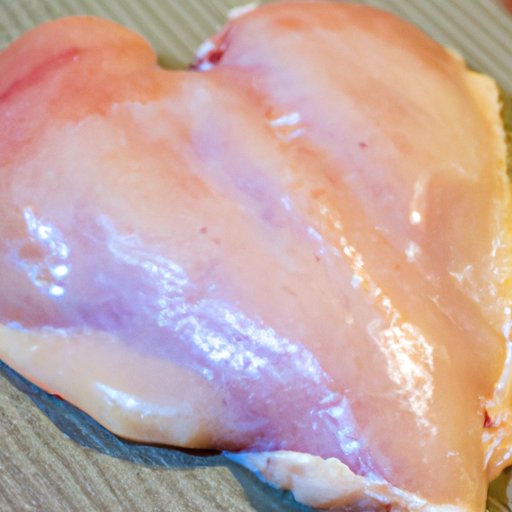
Introduction
Chicken breast is a popular and versatile cut of meat that can be used in countless recipes. However, it’s no secret that chicken breasts are prone to becoming tough and dry, which can make them unappetizing to eat. In this article, we’ll explore several methods for making chicken breast tender and juicy, so you can enjoy this delicious cut of meat to its fullest.
Brining
Brining is a process that involves soaking chicken in a saltwater solution before cooking. The saltwater helps to break down the muscle fibers in the meat, which leads to a more tender result. Here’s a simple recipe and instructions for brining chicken:
- Dissolve 1/4 cup of salt in 4 cups of water.
- Add any desired spices or aromatics to the brine, such as garlic, peppercorns, or rosemary.
- Add the chicken breasts to the brine and refrigerate for at least 1 hour, but no more than 8 hours.
- Remove the chicken from the brine, rinse it with cold water, and pat it dry with paper towels.
- Cook the chicken as desired.
Acidic Marinade
Another method for making chicken tender is to use an acidic marinade. Acidic ingredients such as lemon juice, vinegar, or yogurt help to denature the proteins in the meat, which causes it to break down and become more tender. Here’s a recipe and guidelines for making and using an acidic marinade:
- In a bowl, whisk together 1/4 cup of olive oil, 2 tablespoons of lemon juice, 2 minced garlic cloves, and any desired herbs or spices.
- Add the chicken breasts to the marinade and turn to coat them evenly.
- Cover and refrigerate for at least 30 minutes, or up to 8 hours.
- Remove the chicken from the marinade and discard any excess marinade.
- Cook the chicken as desired.
Pounding
Pounding chicken breasts is a method that breaks down the muscle fibers and creates a more even thickness, which leads to more even cooking and tenderness. Here are some step-by-step instructions for pounding chicken:
- Place the chicken breast between two sheets of plastic wrap or wax paper.
- Using a meat mallet or rolling pin, gently pound the chicken until it is an even thickness, about 1/2 inch thick.
- Season the chicken as desired and cook it immediately.
Low and Slow Cooking
Cooking chicken breasts at a lower temperature for a longer period of time is another way to keep them moist and tender. When cooked at high temperatures, chicken breasts can quickly dry out and become tough. Here are some guidelines for cooking chicken breasts at a lower temperature:
- Preheat the oven to 325°F.
- Season the chicken breasts as desired.
- Place the chicken in a baking dish or on a sheet pan.
- Bake for 25-30 minutes, or until the chicken reaches an internal temperature of 165°F. Check the temperature with a meat thermometer to ensure it’s cooked through.
Basting
Basting chicken with butter or oil during cooking adds flavor and moisture to the meat. The basting process creates a caramelized outer layer that locks in moisture and creates a tender result. Here are some tips and guidelines for basting during cooking:
- Melt butter or oil in a small saucepan over low heat.
- Using a basting brush, coat the chicken with the melted butter or oil every 5-10 minutes during cooking.
- Be careful not to baste too frequently or the chicken may become greasy.
Resting
Resting chicken after cooking allows the juices to redistribute throughout the meat, which results in a more tender and juicier result. Here are some guidelines for resting chicken:
- Remove the chicken from the heat source.
- Cover the chicken with foil and let it rest for 5-10 minutes.
- Do not cut into the chicken immediately or the juices will escape.
Slicing
Slicing chicken against the grain is an important step that affects tenderness. When you slice against the grain, you are cutting through the muscle fibers, which leads to a more tender result. Here are some guidelines for slicing chicken:
- Identify the direction of the grain by looking at the muscle fibers.
- Cut perpendicular to the grain, against the direction of the muscle fibers.
- Cut the chicken into even slices or cubes, as desired.
Conclusion
Now that you have learned several tips and tricks for making chicken breast tender, it’s time to put your knowledge to the test. Whether you choose to brine, marinate, pound, cook low and slow, or baste, you’re sure to end up with a delicious and tender result. Remember to rest your chicken and slice against the grain for maximum tenderness.




